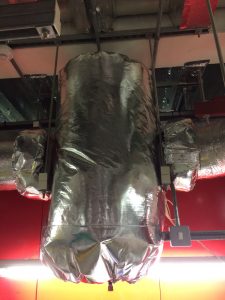Calculation Energy Losses from Exposed Pipework
Have you ever wondered how we calculate the energy losses from exposed pipework which should be covered with insulation jackets?
There are a number of variables which need to by multiplied out to calculate exactly how much energy you are loosing in the boiler house without insulation jackets on your awkward pipe work. Do you get a waft of hot air whicih hits you when you open the boiler house door?
This lost energy is simply going to heat the birds in the trees and can be calculated for the purpose of assessing insulation jackets projects with simple payback (SPB) scenarios.
A good article on payback methods is found here
https://www.accountingtools.com/articles/2017/5/17/payback-method-payback-period-formula
Logic would dictate that in order to calculate combined boiler house losses we need to know the size of the pipe work which is emitting the heat loss into the boiler room.
This is normally recorded on the pipework flange or body e.g. 100mm = 4″ pipe work where one inch is 25mm. The payback on the jacket shortens as the size of the pipe work increases.
This is simply because nearly as much work has to go into forming a small 1″ control valve insulation jacket as would go into a much larger jacket by comparison.
Once we identify all the exposed awkward pieces and cateorgise them into sizes e.g. 2″, 3″, 4″ etc. we now have the total number of pipe work pieces.
The old Energy Efficiency Best Practice Programme which GEM used to refer to used a simple rule of thumb where, for example, one 4″ piece of pipe work requiring an insualtion jacket had the equivalent heat loss per annum as 1meter of the same size straight pipe work.
This allows us to calculate the losses for the different pipe work sizes and we refer to a heat loss table to do this.
Then comes the ancillary items, e.g. annual hours of operation of the heating system, latest instanteneous combustion efficiency of the boiler e.g. 87%, thermal properties of the insulation jacket being deployed e.g. 91%, cost of fuel e.g. €0.03 per kWh etc and away we go!
The pre and post insulation jackets performance is subtracted one form the other and the annual total losses can be calculated to give a ROI or SPB which is normally between 10 – 14 months for 24 hour operated buildingswith heating systems opearting at c. 70 – 80 C
The Carbon Trust UK has produced a useful guide to assist the process
The photo below shows some exposed 4″ gate valves and a 4″ control valve at a Dublin site which GEM subsequently covered with insulation jackets.
GEM insulation jackets are also used to cover calorifier manifolds, butterfly valves, flanges, NRVs, meters, strainers, A&D separators and Heat Exchangers



Photo1. Gate valves, strainers and header ends covered with GEM insulation jackets
Photo 2. Exposed Gate valves and Control valves on the same site
Photo 3. Air & Dirt Separator covered with GEM foil finish insulation jacket with flanged covers and openings for all openings Galway
Recent Comments